Matt Painter motion
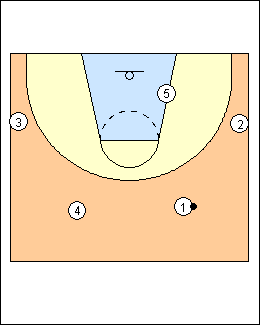 | 1 Matt Painter The product (players) is so important, you can do everything right with a bad product and it doesn't matter, you can do everything wrong with the right product and win a lot of games. The game of basketball is quickness. Everybody runs some sort of motion, when sets break down you go to ballscreens, if the ballscreens don't work you must be able to play and at times without the dribble. You have to get layups and get to the foul line. Defence and rebounding are the two most important things in the game, so motion may be slow to develop in practice. They work on man defence and motion all practice, if you do a lot of different things, you probably won't be good at anything. They run open-post (5-man) motion where they allow different people to post, and 41 (4-out 1-in) where they keep the big inside. If your big won't run or move, anchor him, and play through him, but you can't let big guys walk. You're not coming down and calling sets. You must educate your players about when you have action and when you don't, make them wait, e.g., don't cross sides without a purpose, it's OK when using a backscreen. They are going to make mistakes, when you make a mistake go as hard as you can, get right back into some other action without pulling the ball back to set up. Motion is not that difficult to teach, but you have to stay with it. Players aren't listening to you, give them a written quiz. |
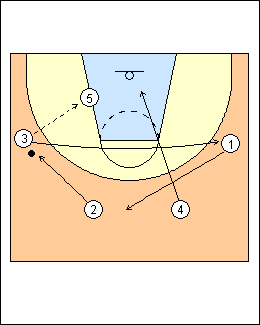 | There are three parts to offence, one is the dribble game (penetration-shoot), those are your rules. Motion makes you perimeter-oriented, you have to you use your dribble, get to the rim on a close-out and get to the foul line, especially in the bonus. Discuss this with the players involved, it's not for the masses. When you get too deep, keep it or stop, pivot and get it back, sometimes breaking your man down gets you into trouble. A second part is the post game, what you do when the ball goes into the post. Painter has 4 dive to the rim, go to a body with hands up, it's a post-up screen, roll on him when the ball gets kicked because the defender needs to rotate. Passer 3 runs through the elbows, 1 gets to the middle, and 2 must get underneath the foul line (5 is double-teamed). The first pass out should be to 1 in the middle (who will get a backscreen from 5 if he passes). If a guard posts up, dive your 5 man every time. If the ball goes inside there's no screening going on, although they will add a weakside flare with certain players. There should never be a player on the opposite block when the ball is on the wing, i.e. no double post. |
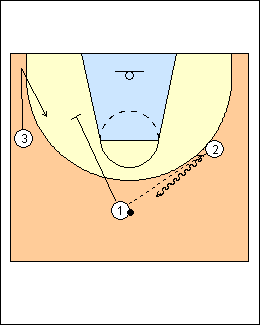 | 3 The third part of offence is motion rules. They start teaching motion like the defence is switching like-size screens, it's a slip-fade, the screener is always the slipper. Using a downscreen on the wing, take your man down, not in, they talk about getting to the baseline (there will be game slippage), it's a sprint. 2 dribbles to the action before it happens, he knows they are going to switch. If 3 is below the block in the corner, there's no setting up his man, it's a sprint cut. |
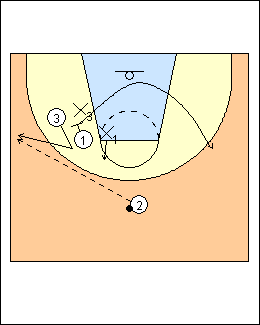 | 4 If X1 is disciplined and pops to switch, 3 fades and 1 goes to the rim. If 1 feels X1 step out, he's gone to the rim. X1 stays in his area and doesn't go with 3 on the fade. If 2 passes to 3, 1 gets out (he's not a big) and backscreens, clearing a side. |
 | 5 Slip-fade a switch on a flarescreen. 3 flarescreens with his back to the sideline, 2 takes his man in like a basket cut, as he gets to the screen, 3 goes to the basket looking for a layup. Once 1 dribbles past the elbow he can't pass inside to 3 (it's across his body against the grain), 3 will get out and backscreen. |
 | 6 However, you can't backscreen for a big who isn't being guarded on the perimeter, his defender is in the paint, so the big will downscreen, his defender isn't showing. If X3 trails the cutter (the defence won't switch a big-little screen), 3 curls, hit him, and 5 dives (shown). If X3 goes around the screen (ballside), 5 changes his angle to lay some wood, 3 fades to the corner. |
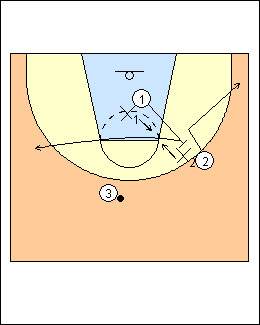 | 7 It's a slip-fade if the defence switches on a backscreen (like-size), 2 sells basket then gets to the corner, 1 gets underneath, there's no angle to go to the basket, they get between the defenders who are switching (Painter is not totally convinced about this). |
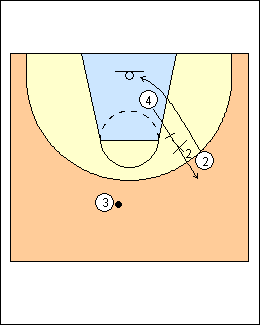 | 8 There no switch on a big-to-little backscreen, 2 goes to get his layup, 4 pops, pass to him if he can shoot or the ballhandler is getting a count or is pressured. If 3 has his 4-4-4 seconds (not dribbled yet), he's fine. 2 has the option to cut through, or come back using a downscreen from 4. |
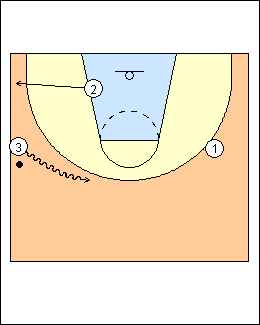 | 9 Centering the ball You want the ball at the top as much as possible, and you want the top occupied, unoccupied, then occupied by another player. There's no cut and (self) replace at the top unless you passed to somebody who can't handle pressure (in a game, guys shoot to alleviate pressure). 3 centers the ball, when he picks up his dribble a guard who is posting will step out to the corner, he can't stay there. If you center it and can't pass, keep your dribble, you can pop back to get a new count. Their motion does a better job of reversing the ball than staring down the action. |
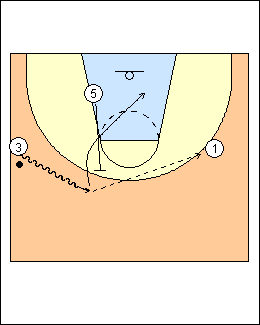 | 10 A big who is dominating can stay in the post, then backscreen on a pass to 1 (don't flare from the block, there's no angle). There's no setting up your man on a backcut, it's a sprint cut to the rim then pick up the ball, it gets you layups. 3 can clear, or 5 can get him again. |
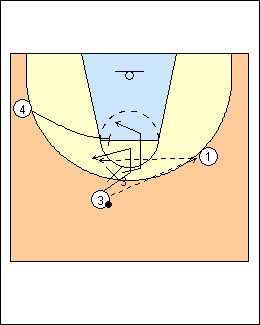 | 11 On a pass to 1 it's a downscreen (big to little) or a flarescreen (big to little), but the angle is awful, 3 must take his man into the middle, come off a flare (or screen down), it's almost a carioca, he opens up his shoulder, if his man goes around the screen, 3 wants to stop and catch with the screener's head between the ball and the rim (shown). If 3 doesn't get centered to get his angle, you're going to see a defender streak for a dunk at the other end. |
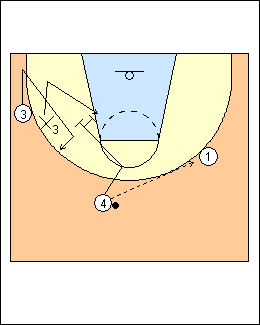 | 12 On a downscreen, the screener and cutter both call "change" if the cutter's defender goes around the screen, the screener turns and head hunts, the cutter should draw a line between himself, the screener's head, and the rim. It's the same thing as a flare. If X3 stays tight, 3 tight curls and screener 4 pops back. |
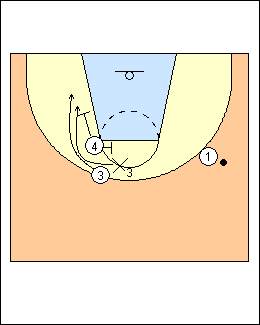 | 13 Second action If X3 stays tight (chases) on the flarescreen, 4 can go get him again with a downscreen, if X3 chases on that, 3 tight curls, X4 has to show, 4 dives to the rim for a dunk on a catch by 3. This is how bigs will score, also on downscreen and change. They need to feel good, because you are doing a lot not to get them the basketball. Do second-action shooting in practice (use chairs or managers), including downscreen into flarescreen. Don't use coaches to pass in practice. |
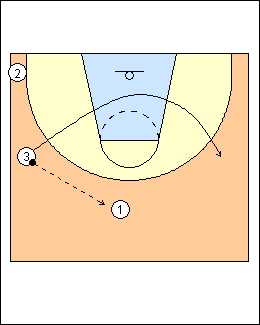 | 14 With an overload on one side, 3 must basket cut after passing to 1, there's no angle to downscreen. |
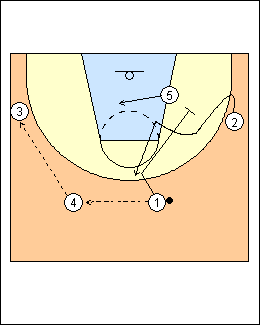 | 15 Post man From 3 on 3 add a post, to start if you post and they pass to someone else, you can't stay posted (you screen), after two weeks allow the post to stay if he has a seal. With 41 motion, anchor the post, and constantly look at him. 1 passes to 4 and downscreens for 2, 5 follows the ball. 2 tights curls, 4 passes to 3, 2 has to raise, if he curls and goes to the corner, his defender can help on 5 (also come to the midline and pop out if you come off a downscreen and see that the ballhandler is in trouble). 4 will cut through on the pass to 3, he can't stand, occupy the top then unoccupy. They run transition motion, there's rules but no set action. A big whose defender is in the lane has to screen - downscreen, flare, ballscreen. If you ballscreen or dribble hand-off with a big who can't shoot, don't pick and pop (even in practice), he must go straight to the rim. A high-low pass doesn't have to be from the other big, if guards catch at 22 feet from the basket. |
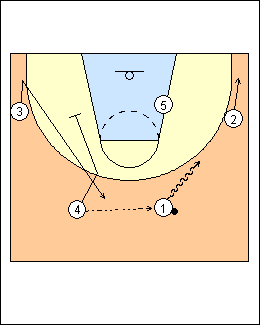 | 16 4 passes to 1 and downscreens for 3 while 1 dribbles down, 3 has to see that 1 is trying to get the ball to 5, and 3 pops out. |
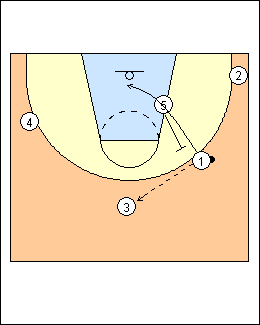 | 17 5 backscreens for 1 on a pass to 3. |
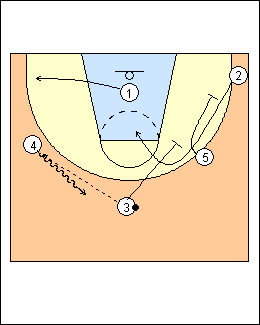 | 18 2 in the corner sees it all and asks for a screen from 5, 3 makes it a single-single (stagger), 2 curls through (they take the switch on the single-single, instead of 3 slipping). 3 could basket cut when 5 goes to downscreen. 5 can't flarescreen for 3 with 2 in the corner. |
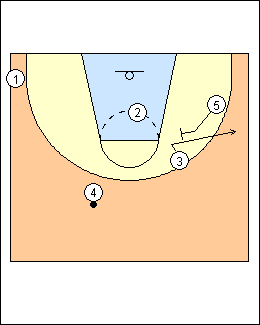 | 19 5 flares 3 - flare off the top on a like-size single-single. |
This page was made with Basketball playbook from Jes-Soft